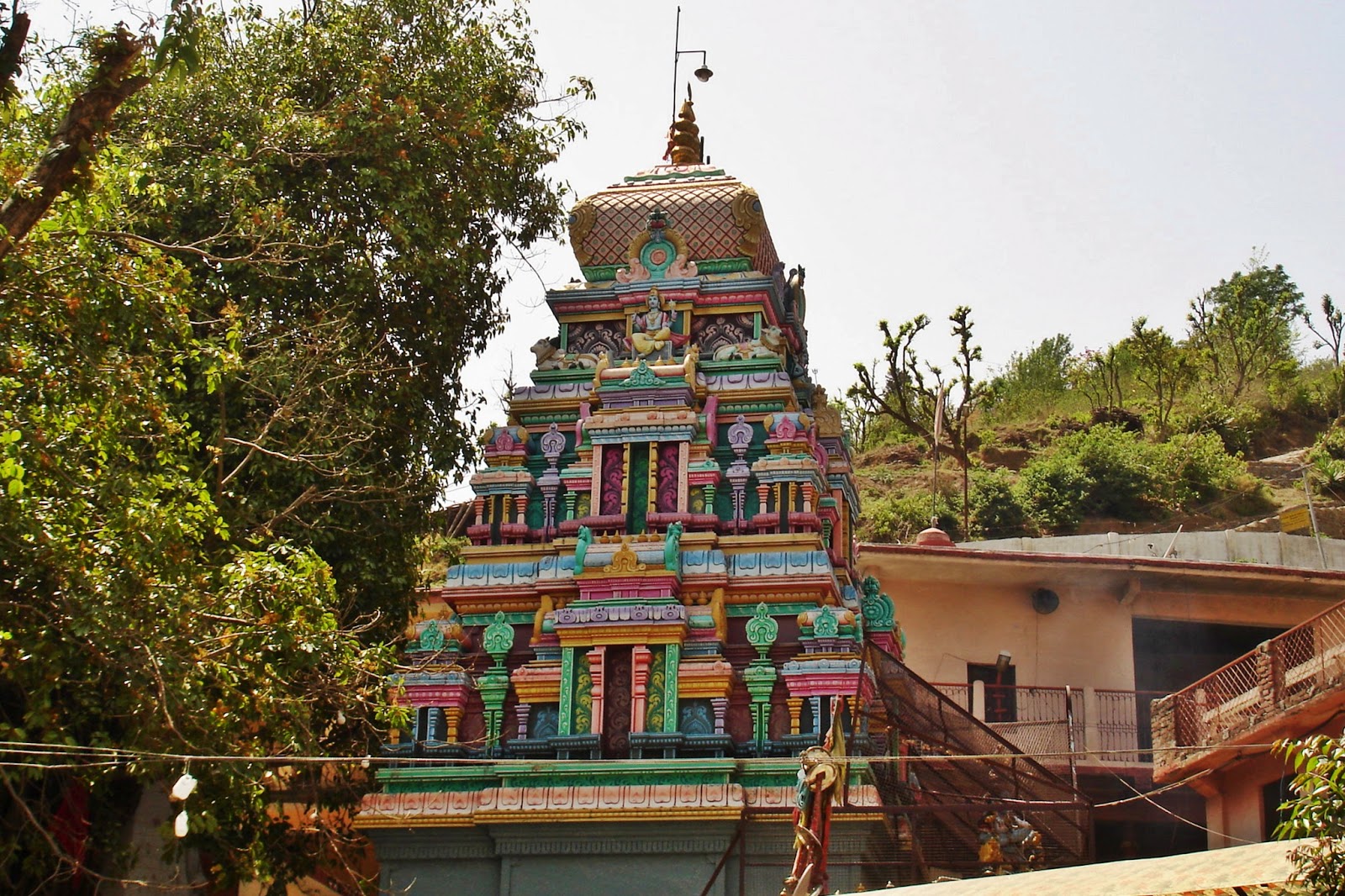In the mystical folds of the Garhwal Himalayas, where the air hums with the sound of temple bells and the rustle of ancient deodar trees, lies one of the most spiritually significant Shiva temples in northern India — the Neelkanth Mahadev Temple. Located just 32 kilometers from the spiritual gateway of Rishikesh and nestled within the serene Pauri Garhwal district of Uttarakhand, this temple is more than a place of worship. It is a living testament to one of the most profound episodes in Hindu cosmology — the churning of the cosmic ocean, the emergence of a deadly poison, and the selfless act of Lord Shiva who drank it to save the universe.
Known as Neelkanth, meaning “The Blue-Throated One,” Lord Shiva is revered here in the form of a sacred Shivalinga, believed to have been established after his intense penance to neutralize the effects of the poison. The temple, surrounded by lush green forests, pristine rivers, and towering mountain ranges, offers not only a pilgrimage experience but also a journey into the heart of Indian mythology, devotion, and natural beauty.
This article explores the legend, history, architecture, spiritual significance, rituals, festivals, and the pilgrimage experience of the Neelkanth Mahadev Temple, offering readers a holistic understanding of this divine sanctuary.

Geographical and Natural Setting: Where Heaven Meets Earth
The Neelkanth Mahadev Temple is situated in the village of Neelkanth, near the town of Dhanaulti, in the Tehri-Garhwal region of Uttarakhand. Perched at an altitude of approximately 1,170 meters (3,840 feet) above sea level, the temple lies in a secluded valley embraced by the Nar-Narayan mountain ranges — twin peaks that symbolize the divine presence of Lord Vishnu (Narayan) and the sage Nar, often associated with austerity and meditation.
The temple is located at the confluence of two sacred rivers — the Pankaja and the Madhumati — whose crystal-clear waters flow down from the Himalayan glaciers, believed to be infused with spiritual energy. This sacred sangam (confluence) enhances the temple’s sanctity, as such junctures are considered highly auspicious in Hindu tradition, ideal for meditation, purification, and divine communion.
Surrounded by dense pine, deodar, and rhododendron forests, the site exudes a tranquil and meditative atmosphere. The area is part of the Uttarkashi forest division, known for its rich biodiversity and untouched natural beauty. The cool mountain breeze, the chirping of birds, and the distant sound of flowing water create an ambiance that feels almost otherworldly — a perfect setting for a temple dedicated to the ascetic and meditative form of Lord Shiva.
The journey to Neelkanth Mahadev begins from Rishikesh, a spiritual hub on the banks of the Ganges. The drive winds through scenic hills, terraced farms, and quaint villages, culminating in a final 3-kilometer trek through a forested path that leads to the temple complex. This gradual ascent mirrors the spiritual journey — a symbolic shedding of worldly distractions before entering the divine presence.
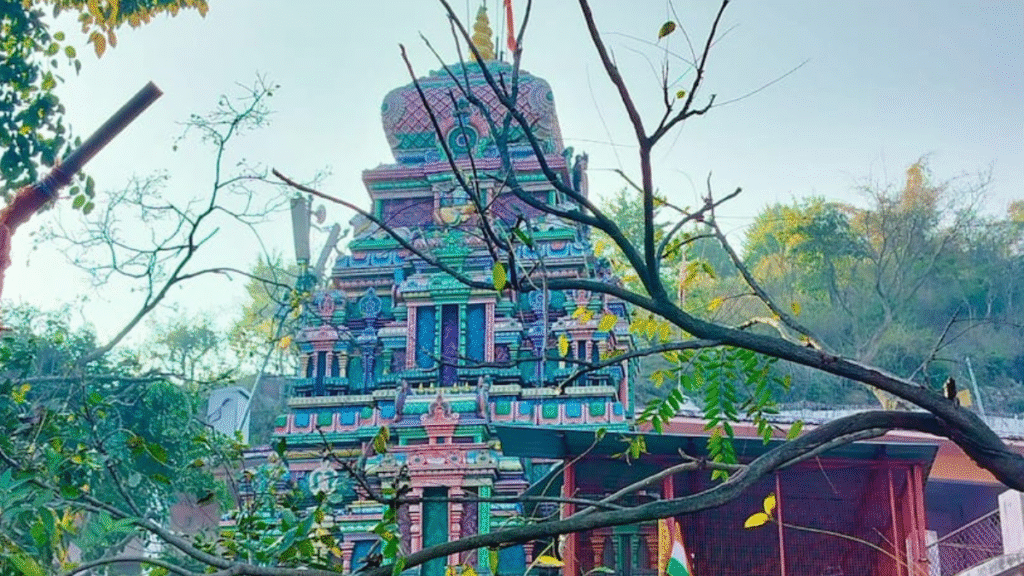
The Legend of Neelkanth: Shiva and the Churning of the Ocean
At the heart of the Neelkanth Mahadev Temple lies one of the most powerful and enduring myths in Hindu tradition — the Samudra Manthan, or the Churning of the Ocean of Milk. This cosmic event, described in sacred texts like the Vishnu Purana, Bhagavata Purana, and Shiva Purana, is not merely a mythological tale but a symbolic narrative of the eternal struggle between good and evil, creation and destruction, and the role of divine grace in maintaining cosmic balance.
The Quest for Amrita
According to the legend, the Devas (gods) and Asuras (demons) once joined forces to churn the Kshira Sagara, the cosmic ocean, in search of Amrita, the nectar of immortality. To churn the ocean, they used the mighty Mount Mandara as the churning rod and the serpent Vasuki as the rope. Lord Vishnu took the form of Kurma, the divine tortoise, to support the mountain on his back, preventing it from sinking into the ocean.
As the churning progressed, numerous divine treasures emerged — the Kamadhenu (wish-fulfilling cow), Uchhaishravas (seven-headed horse), Parijat tree, Lakshmi (goddess of wealth), and others. However, amidst these blessings, a terrifying event occurred — the emergence of Halahala, a deadly poison so potent that it threatened to destroy all of creation.
The fumes of the poison began to scorch the heavens and the earth. The Devas and Asuras, paralyzed with fear, turned to the supreme deities for help. None dared to consume the poison — until Lord Shiva stepped forward.
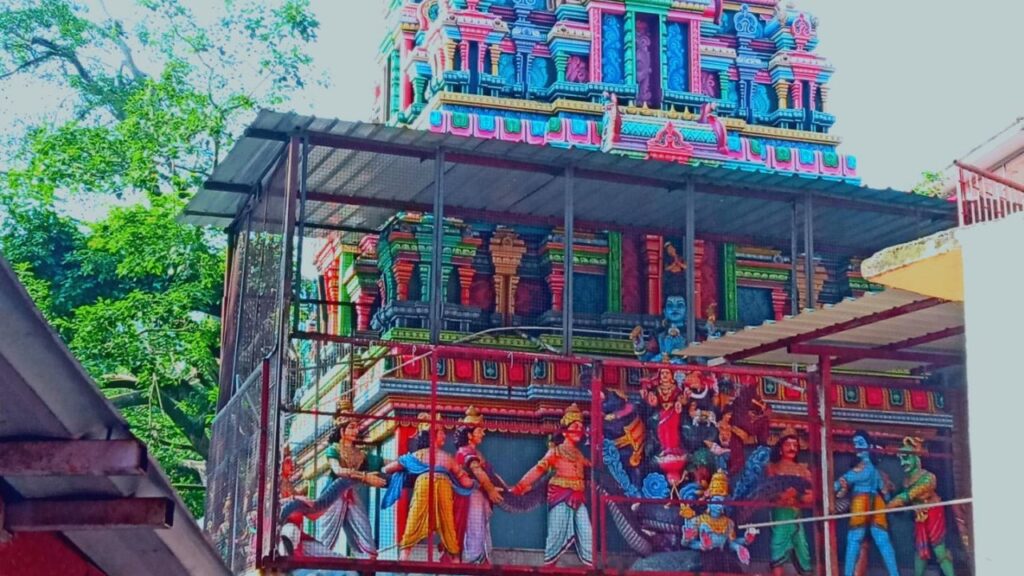
The Sacrifice of the Supreme
Moved by compassion for all beings, Lord Shiva resolved to drink the poison to save the universe. As he consumed the Halahala, his consort Goddess Parvati, alarmed by the danger, rushed to stop him. In a symbolic gesture of love and protection, she clutched his throat, preventing the poison from descending into his body.
The poison remained trapped in Shiva’s throat, turning it a deep blue. From that moment, he came to be known as Neelkanth — the Blue-Throated One. This act of supreme sacrifice elevated Shiva not only as the destroyer in the Hindu trinity but also as the ultimate protector — the one who bears the world’s suffering so that life may continue.
The Penance at Neelkanth
According to local belief and scriptural references found in the Shruti-Smriti Puranas, after consuming the poison, Lord Shiva retreated to the tranquil valley now known as Neelkanth to meditate and neutralize its effects. He is said to have performed intense penance for 60,000 years at the confluence of the Pankaja and Madhumati rivers, seated beneath a sacred Panchpani tree — a five-leaved fig tree believed to possess healing and purifying properties.
It was here, after his prolonged meditation, that Shiva installed a Shivalinga in the shape of a throat — symbolizing the very site where the poison was held. This lingam, known as Neelkanth Mahadev, remains the central deity of the temple and is worshipped as a manifestation of Shiva’s compassion, strength, and transcendence.
The location of the temple is thus not arbitrary — it is believed to be the exact spot where this divine event occurred, making it one of the holiest Shiva sites in the Himalayan region.
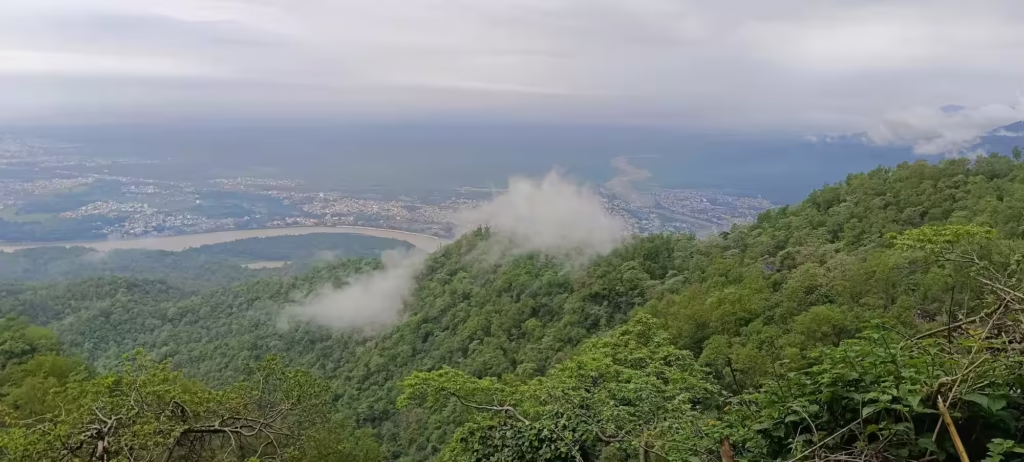
The Architecture: A Dravidian Jewel in the North
One of the most striking aspects of the Neelkanth Mahadev Temple is its distinctive architectural style, which stands in contrast to the typical Nagara-style temples of North India. Instead, the temple reflects the Dravidian architecture of South India, particularly reminiscent of the grand temples of Tamil Nadu built by the Pandya and Chola dynasties.
This architectural fusion is both surprising and fascinating, suggesting possible historical influences, migrations of artisans, or deliberate design choices to reflect a pan-Indian spiritual identity.
The Gopuram and Shikhara
The temple is crowned by a towering gopuram (gateway tower), also referred to as the shikhara in North Indian terminology. Rising in a tiered, pyramid-like structure, the gopuram is adorned with intricate stone carvings, friezes, and motifs that narrate scenes from Hindu mythology.
The most prominent theme depicted on the shikhara is the Samudra Manthan — the very legend that gives the temple its significance. Sculptures of Devas and Asuras are shown pulling the serpent Vasuki, with Mount Mandara at the center and Lord Vishnu in his Kurma avatar supporting it. Lord Shiva is depicted in the act of consuming the poison, his throat glowing blue, while Goddess Parvati stands beside him in a protective pose.
These carvings are not merely decorative; they serve as visual scriptures, educating devotees about the temple’s sacred history and reinforcing the moral and spiritual lessons of sacrifice, balance, and divine intervention.
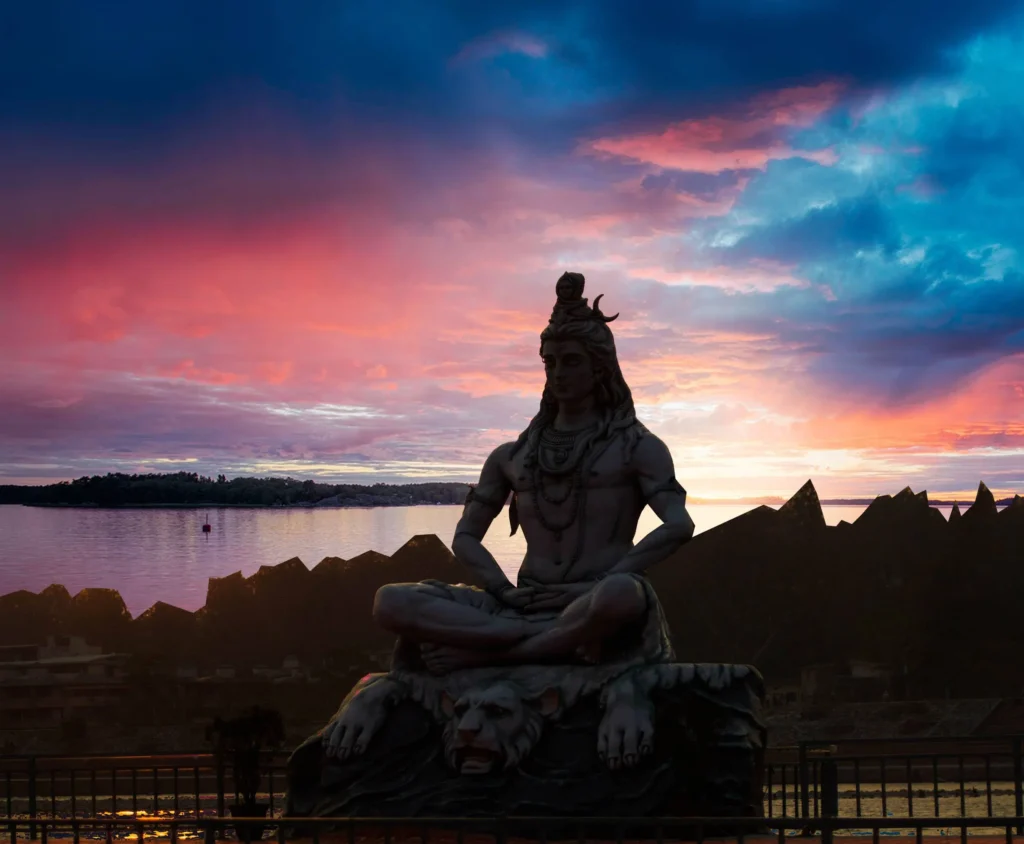
The Sanctum Sanctorum (Garbha Griha)
At the heart of the temple lies the Garbha Griha, the inner sanctum, which houses the Neelkanth Shivalinga. The lingam is made of black stone and is shaped in a unique throat-like form, symbolizing the exact location where the poison was held. Devotees believe that the lingam radiates a cool, calming energy, especially during meditation and prayer.
The sanctum is built directly over the Panchpani tree, whose roots are said to intertwine with the base of the lingam. This sacred tree is considered a living witness to Shiva’s penance and is protected with great reverence. Offerings of flowers, milk, and bilva leaves are often placed near its roots.
The Temple Complex and Natural Spring
The temple complex is designed to harmonize with nature. A natural spring emerges near the temple premises, believed to be fed by the same underground currents that nourish the Pankaja and Madhumati rivers. This spring, known as Amrit Kund or Papnashini Kund, is considered holy, and devotees take a ritual bath in its waters before entering the temple. The water is cold, clear, and refreshing — believed to cleanse not only the body but also past sins (pap).
Surrounding the main shrine are smaller shrines dedicated to Goddess Parvati, Lord Ganesha, and Lord Kartikeya, forming a complete family of the divine. A spacious pradakshina path (circumambulation path) allows devotees to walk around the sanctum in reverence, a practice believed to accumulate spiritual merit.
The entire complex is built with locally sourced stone and blends seamlessly into the natural landscape, reflecting the ancient Indian principle of Vastu Shastra — the science of harmonious architecture aligned with nature and cosmic energies.
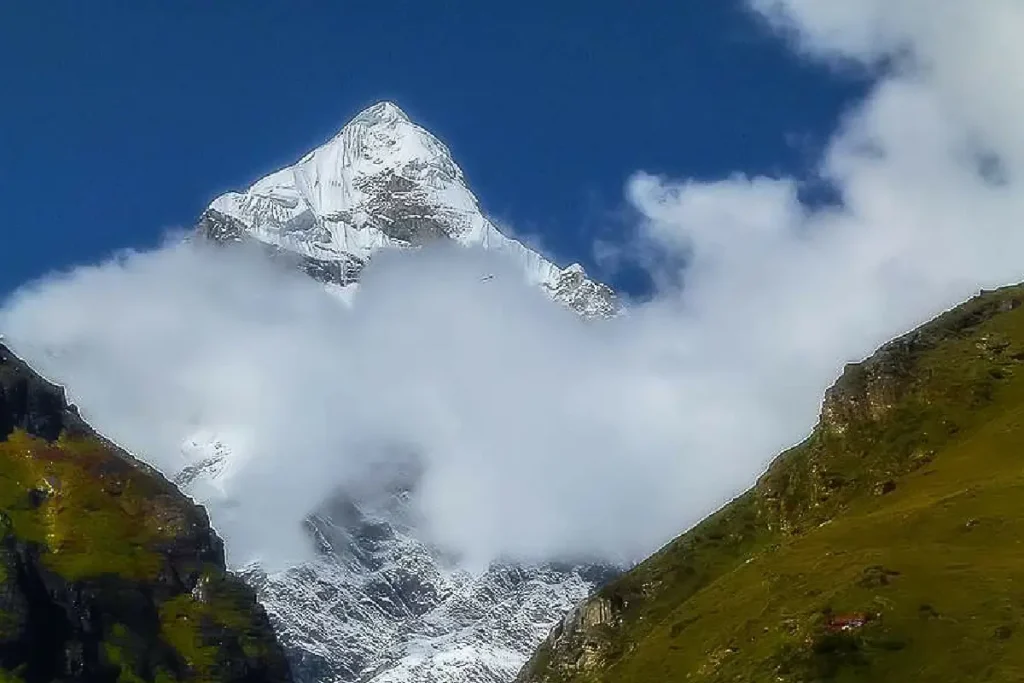
Spiritual Significance: Why Neelkanth Mahadev Matters
The Neelkanth Mahadev Temple is more than a historical or architectural marvel — it is a power center of spiritual energy. Pilgrims believe that visiting this temple, especially with a pure heart and sincere devotion, can lead to inner transformation, healing, and liberation (moksha).
A Symbol of Selfless Sacrifice
At its core, the story of Neelkanth is a lesson in selflessness, courage, and compassion. Lord Shiva, though beyond suffering, chose to bear the pain of the universe. This act resonates deeply with devotees, especially in times of personal crisis. Many come to the temple seeking strength, offering prayers for relief from physical, emotional, or spiritual suffering.
The blue throat of Shiva is a reminder that true power lies not in destruction, but in the ability to absorb and transform negativity. In a world often overwhelmed by anger, greed, and fear, the image of Neelkanth serves as a beacon of hope and inner resilience.
A Site of Penance and Healing
The temple is also considered a tirtha — a sacred ford or crossing point between the material and spiritual worlds. The combination of the confluence of rivers, the natural spring, the ancient tree, and the high mountain energy creates a unique vibrational field conducive to meditation and healing.
Many sadhus (ascetics), yogis, and spiritual seekers visit Neelkanth to meditate in silence, drawn by the belief that Shiva’s presence is especially strong here. The air is said to be charged with prana (life force), and the silence of the forest amplifies inner awareness.
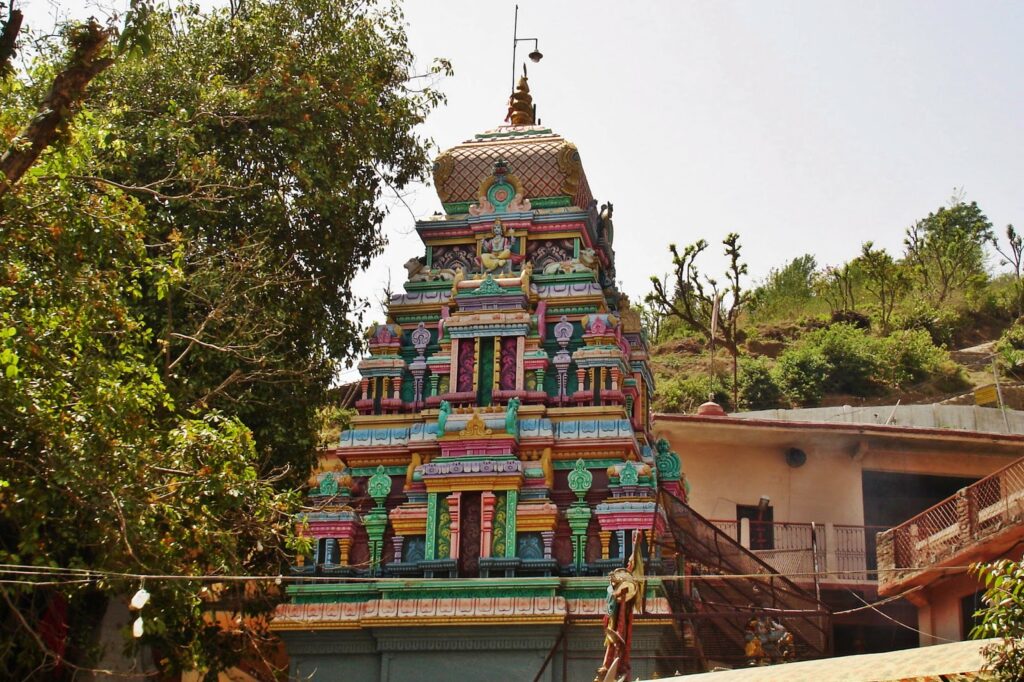
Connection to the Panch Kedar and Other Shiva Sites
While not part of the official Panch Kedar pilgrimage (Kedarnath, Tungnath, Rudranath, Madhyamaheshwar, and Kalpeshwar), Neelkanth Mahadev is often included in extended Shiva pilgrimages in Uttarakhand. Its proximity to Rishikesh, Haridwar, and the Char Dham route makes it an accessible yet deeply significant stop for devotees.
Some scholars and spiritual leaders even refer to Neelkanth as the “Sixth Kedar”, emphasizing its unique mythological importance and spiritual potency.
Rituals and Worship: The Daily Rhythm of Devotion
Worship at the Neelkanth Mahadev Temple follows the traditional Panchayatana Puja system, with daily rituals performed by trained priests (pandas) in accordance with Agama Shastras — ancient scriptures governing temple worship.
Daily Pujas and Aartis
The temple opens early in the morning, around 5:00 AM, with the Mangala Aarti, a devotional hymn accompanied by the ringing of bells, chanting of mantras, and the waving of lamps. This is followed by Abhishekam — the ritual bathing of the Shivalinga with milk, honey, yogurt, ghee, sugar, and water. Each offering symbolizes a different quality — purity, sweetness, nourishment, and surrender.
Throughout the day, additional pujas are performed, including:
- Shringar Aarti (morning decoration of the deity)
- Bhog Aarti (offering of food)
- Sandhya Aarti (evening prayer)
- Shayan Aarti (night-time lullaby before closing)
Devotees are encouraged to participate in these rituals, either by offering prayers, lighting lamps, or sponsoring abhishekam.
Offerings and Prasad
Common offerings at the temple include:
- Bilva (Bael) leaves — considered especially dear to Lord Shiva
- Coconuts — symbolizing the breaking of the ego
- Milk and water — for purification
- Flowers and incense — for fragrance and devotion
- Fruits and sweets — as symbols of gratitude
After the rituals, prasad (blessed food) is distributed to devotees. It typically includes coconut pieces, bananas, and sweet rice, believed to carry the divine grace of Lord Shiva.
The Significance of Bilva Leaves
One of the most sacred offerings at Neelkanth is the Bilva leaf, which has three leaflets representing the Trinity of Shiva, Vishnu, and Brahma, or the three eyes of Shiva. According to legend, even a single bilva leaf offered with devotion can erase lifetimes of sin. The temple has a dedicated Bilva tree in its courtyard, and devotees often bring leaves from their own homes as a mark of personal devotion.
Festivals and Fairs: When the Mountains Come Alive
The Neelkanth Mahadev Temple comes alive during two major annual festivals, drawing thousands of pilgrims, sadhus, and cultural enthusiasts from across India.
1. Maha Shivaratri (February–March)
Maha Shivaratri, the “Great Night of Shiva,” is the most important festival at the temple. Celebrated on the 14th night of the dark fortnight in the Hindu month of Phalguna (February–March), it marks the night when Lord Shiva performed the Tandava — the cosmic dance of creation and destruction.
During Maha Shivaratri, the temple is illuminated with thousands of oil lamps and colorful lights. Special jagrans (night-long prayers) are held, with continuous chanting of “Om Namah Shivaya” and recitations of the Shiva Chalisa and Shiva Tandava Stotram.
Priests perform a grand abhishekam with over 108 pots of milk, honey, and water. Devotees observe fasts, meditate, and stay awake all night in devotion. The atmosphere is electric with faith, music, and collective spiritual energy.
2. Shravan Shivratri (July–August)
The Shravan month in the Hindu calendar (July–August) is considered especially auspicious for worshipping Lord Shiva. During this time, the temple hosts another major Shivratri celebration, coinciding with the Kanwar Yatra.
The Kanwar Yatra: A Journey of Faith
Every year during Shravan, thousands of Kawarias — devotees of Shiva — undertake a sacred pilgrimage from Haridwar to the Neelkanth Mahadev Temple. Clad in saffron robes, carrying kanwars (bamboo poles with pots of Ganga water), they walk barefoot for over 30 kilometers through mountain trails.
This arduous journey is a test of devotion, endurance, and surrender. The Kawarias believe that offering Ganga water to Lord Shiva at Neelkanth will fulfill their wishes and bring blessings to their families.
The sight of thousands of Kawarias walking in unison, chanting “Bam Bam Bhole!”, is both awe-inspiring and deeply moving. The government and local authorities provide medical aid, food stalls, and resting points along the route to support the pilgrims.
Other Festivals
- Navratri: While primarily dedicated to the Goddess, Navratri is also observed with special pujas to Shiva as the consort of Parvati.
- Diwali: The temple is beautifully lit, and a special Lakshmi-Puja is performed alongside Shiva worship.
- Shravan Mondays: Every Monday of the Shravan month sees a surge in devotees, who offer milk and bilva leaves to the lingam.
The Pilgrimage Experience: A Journey of the Soul
Visiting the Neelkanth Mahadev Temple is not just a physical journey — it is a spiritual odyssey. Whether you are a devout Hindu, a spiritual seeker, or a nature lover, the experience leaves a lasting impression.
How to Reach
- By Air: The nearest airport is Jolly Grant Airport in Dehradun (65 km away).
- By Train: The closest railway station is Rishikesh (32 km), well-connected to Delhi and other major cities.
- By Road: Regular buses and taxis operate from Rishikesh, Haridwar, and Dehradun. The road up to the temple base is well-maintained, but the final 3 km is a trek through a forest path, adding to the spiritual symbolism of the journey.
Best Time to Visit
The ideal time to visit is between March and June, and September to November, when the weather is pleasant and the skies are clear. The monsoon season (July–August) is spiritually vibrant due to the Kanwar Yatra, but landslides can sometimes disrupt travel. Winters (December–February) are cold, with occasional snow, offering a serene, snow-clad experience for the adventurous.
Accommodation and Facilities
While the temple itself does not have guest houses, there are several dharamshalas, ashrams, and eco-resorts in and around Dhanaulti and Chamba. Basic facilities like restrooms, drinking water, and first aid are available near the temple. Food stalls offer vegetarian meals, tea, and snacks.
Tips for Pilgrims
- Wear comfortable clothing and shoes suitable for trekking.
- Carry a water bottle, light jacket, and umbrella.
- Respect the sanctity of the site — no non-vegetarian food, alcohol, or loud behavior.
- Take the trek slowly; meditate on each step as a form of prayer.
- Silence your phone and immerse yourself in the peace of the place.
FAQs on Neelkanth Mahadev Temple (Uttarakhand)
1. Where is Neelkanth Mahadev Temple located?
The temple is situated about 32 km from Rishikesh, in Pauri Garhwal district of Uttarakhand, surrounded by dense forests and the Nar-Narayan mountain ranges.
2. Which deity is worshipped at Neelkanth Mahadev Temple?
The temple is dedicated to Lord Shiva in his Neelkanth form, meaning “blue-throated one,” who drank the Halahala poison during the Samudra Manthan.
3. What is the mythological significance of the temple?
According to legend, this is the place where Lord Shiva consumed the deadly poison that emerged during the churning of the ocean, turning his throat blue.
4. What is the best time to visit Neelkanth Mahadev Temple?
The temple is open year-round, but the best time to visit is between February–June and September–November when the weather is pleasant.
5. How can one reach Neelkanth Mahadev Temple?
It can be reached via a 32 km road from Rishikesh. Many devotees also trek 12–14 km through the forest route from Ram Jhula in Rishikesh.
6. Are there any special festivals celebrated here?
Yes, the temple witnesses huge gatherings during Maha Shivratri and Shravan month (July–August) when devotees offer water and bel leaves to Lord Shiva.
7. Is there any entry fee for visiting the temple?
No, entry to Neelkanth Mahadev Temple is free. Visitors only need to follow the temple’s traditional dress and decorum guidelines.
8. What is the temple’s architecture like?
It features a traditional North Indian style with intricate carvings of deities and mythological stories. The sanctum houses a self-manifested Shiva Lingam.
9. Can women visit Neelkanth Mahadev Temple?
Yes, women devotees are allowed to enter and offer prayers. The temple is open to all, regardless of gender or caste.
10. Are facilities available near the temple?
Yes, there are small shops selling prasad, tea stalls, and basic accommodation in nearby areas, though many visitors prefer to stay in Rishikesh.

